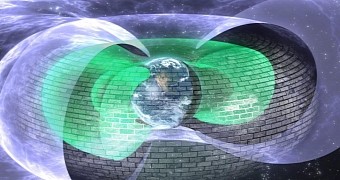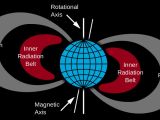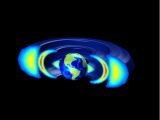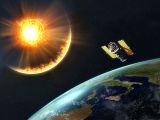It just so happens that our home planet is way cooler than most people would give it credit for. Apart from the fact that it can sustain life, which is nothing short of impressive, it's surrounded by an invisible shield that keeps us safe from murderous electrons.
Or so say researchers with the University of Colorado Boulder in the US, who describe this so-called invisible shield that protects Earth against killer electrons originating from space in a paper published in the journal Nature this November 27.
Crash course in Earth's anatomy
In 1958, scientist James Van Allen with the University of Iowa and fellow researchers used data obtained with the help of Explorer 1, the first satellite launched by the US, to document the presence of two zones packing myriads of high-energy charged particles around our planet.
These zones encircling Earth eventually came to be known as the Van Allen radiation belts. Scientists describe them as two rings whose shape resembles that of a donut. Interestingly enough, evidence at hand indicates that Jupiter and Saturn are too encircled by such radiation belts.
The coolest part about these belts is that they can vary in size. Thus, scientists say that, since their discovery until now, the Van Allen radiation belts have been documented to shrink and expand, sometimes even merge or throw a fit and create a third belt.
In fact, it was back in September 2012 that particles chased out of the outer belt came to form a third radiation ring. This ring, that scientists say was made up of electrons moving at nearly the speed of light, only persisted for about a month.
Having taken the time to study the behavior of Earth's Van Allen radiation belts over the years, researchers say that, generally, the inner ring spans from 400 to 6,000 miles (about 650 to 9,700 kilometers) above the planet's surface.
The outer ring, on the other hand, is said to stretch from 8,400 to 36,000 miles (approximately 13,500 to 58,000 kilometers) above Earth's surface, scientists with the US National Aeronautics and Space Administration (NASA) explain.
Introducing Earth's Star Trek-like shield
The Star Trek-like invisible shield that the University of Colorado Boulder scientists and fellow researchers say protects our planet and, well, us, from killer electrons moving at near-light speed was discovered with the help of NASA's Van Allen Probes, launched on August 30, 2012.
The shield is said to hover some 7,200 miles (roughly 11,600 kilometers) above Earth, at the inner edge of the outer Van Allen radiation belt. This barrier keeps high-energy particles moving at about 100,000 miles per second (nearly 161,000 kilometers) per second from entering our planet's atmosphere.
“It’s almost like theses electrons are running into a glass wall in space. Somewhat like the shields created by force fields on Star Trek that were used to repel alien weapons, we are seeing an invisible shield blocking these electrons. It’s an extremely puzzling phenomenon,” says researcher Daniel Baker.
“When you look at really energetic electrons, they can only come to within a certain distance from Earth. This is completely new. We certainly didn't expect that,” adds Shri Kanekal, deputy mission scientist for the Van Allen Probes at NASA's Goddard Space Flight Center in Greenbelt, Maryland.
Writing in the journal Nature, Professor Daniel Baker and fellow researchers explain that the electrons that this invisible barrier keeps us safe from are known to degrade space systems and even fry satellites. What's more, they constitute a threat to astronauts.
How did this invisible shield form?
Not to burst anyone's bubble or anything of the sorts, but the fact of the matter is that, at least for the time being, scientists cannot say for sure how and why our planet came to have this Star Trek-like barrier hovering over it.
One theory that was eventually proven wrong pointed the finger at Earth's magnetic field lines as the working force behind the invisible shield. Another argued that signals from man-made transmitters were the barrier's engineers. This second theory was too dismissed at a closer look.
The one theory that is still holding on for dear life is the one saying that the Star Trek-like invisible shield is the creation of our planet's plasmasphere, i.e. a ginormous cloud of cold, electrically charged gas that starts some 600 miles (960 kilometers) above Earth and expands all the way into the outer Van Allen belt.
More precisely, researchers have reasons to believe that the electrons are scattered by electromagnetic waves birthed by Earth's plasmasphere. Still, they stress that further investigations need be carried out until they can say for sure that this is indeed the case.
“I think the key here is to keep observing the region in exquisite detail, which we can do because of the powerful instruments on the Van Allen probes,” explains University of Iowa researcher Daniel Baker.

 14 DAY TRIAL //
14 DAY TRIAL // 



